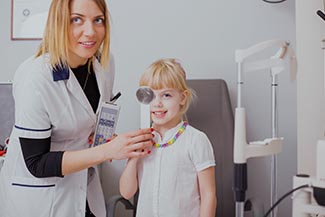Children’s Eye Exams - Pediatric Eye Exams
It is estimated that 80% of what a child learns in school is acquired through vision.
Undetected vision problems can be inaccurately diagnosed with ADHD or learning disabilities. When vision issues in children are detected early, children are able to avoid these problems. Children are also more likely to respond better to treatment the earlier the vision issue is caught. Finding and treating minor vision issues early can prevent more serious vision problems in the future.
Our pediatric optometrists will conduct a pediatric vision screening and comprehensive pediatric eye exam in order to screen for any vision issues and help your child see clearly.
Set your child up for success in school by ensuring that their vision is in tip top shape!
When Should Your Child Have Their First Exam?
Our pediatric eye doctors recommend that you schedule a child’s first official eye exam before they start preschool or kindergarten. Your child’s pediatrician should screen their vision at their regular wellness check ups at the 6 month, one year, and three year mark.
Signs that your child might have an eye or vision problem:
- Poor visual tracking
- Constant eye rubbing
- Chronic redness of the eye
- Poor focusing
- Chronic watering of the eye
If your child shows any of the symptoms above before pre-school, a pediatric vision screening by an eye doctor is encouraged.
Pediatric Vision Issues
Myopia (Nearsightedness)
The number of myopia cases in children has sharply risen in the past decade, and is one of the largest problems impacting children’s vision in the U.S. In the U.S. 40% of children are already myopic (over 14 million children).
Symptoms
- Blurry vision while looking at distant objects
- Squinting while looking at objects
- Headaches
- Sitting close to a television screen or computer screen
- Apparent unawareness at distant objects
- Frequent rubbing of eyes
The Cause of Myopia?

Myopia is caused by a combination of lifestyle and genetics. Risk factors include:
- Family history of myopia
- Insufficient time spent outdoors
- Increased screen time
Myopia in children will progress until around the age of 20, when the eye stops growing. Due to the progressive nature of the condition in children, it is vital that they have regular eye appointments and a treatment plan in place to slow the progression.
Delaying the onset of myopia may also reduce the severity of vision issues down the road.
Treatment of Myopia
While there is no cure for myopia, however, careful management is vital to prevent the condition from causing sight-threatening issues in the future. These issues can include cataracts, myopic maculopathy, retinal detachment, and glaucoma.
Our eye doctors are trained myopia specialists who are ready to assist you in creating a personalized treatment plan for your child. Treatment plans vary from child to child, but can include the following:
- Contact Lenses
- Pharmacologic Interventions
- Orthokeratology
- Increase time outdoors
- Limit screen time
- Convergence Insufficiency
- Eye Tracking Difficulty
- Vision Therapy
Amblyopia (Lazy Eye)
Pediatric amblyopia occurs when one eye does not develop properly during childhood. This results in poor vision and depth perception. If untreated, it can lead to functional blindness in adulthood.
A child can be born with amblyopia, or it can develop in childhood. When a child has amblyopia, their brain will start to “turn off” the bad eye and start to primarily use the good eye due to blurry vision. Amblyopia is treatable, and there are several treatment options.
Amblyopia Treatment Options Include:
- Atropine eye drops
- A new corrective lens prescription for nearsightedness or farsightedness
- Patching one eye
- Surgery
Strabismus (Crossed Eyes/Wandering Eye)
Strabismus occurs when the eyes are not lined up properly or when one/both of the eyes wander. In some children, strabismus is very apparent. In others, strabismus only is noticeable when they are tired or trying to see something far away.
Strabismus can be fixed if it is treated early. If left undetected and untreated, the child can develop amblyopia. Their brain will start to “turn off” the images from the misaligned eye and rely fully on the other eye.
Strabismus Treatment Options Include:
- Patching one eye
- Eye muscles exercises
- Eyedrops
- Eyeglasses
- Eye muscle surgery
Our doctors at Mill Creek Family Eye Center specialize in pediatric eye exams and screenings. Scheduling a pediatric eye exam before your child attends school is important to ensure their success. Call now to schedule an appointment with our pediatric eye doctors.


